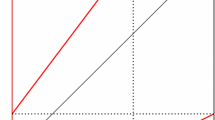Abstract
Let G be a group. We say that an element f ∈ G is reversible in G if it is conjugate to its inverse, i.e. there exists g ∈ G such that g −1 fg = f −1. We denote the set of reversible elements by R(G). For f ∈ G, we denote by R f(G) the set (possibly empty) of reversers of f, i.e. the set of g ∈ G such that g −1 fg = f −1. We characterise the elements of R(G) and describe each R f(G), where G is the the group of biholomorphic germs in one complex variable. That is, we determine all solutions to the equation f ◦ g ◦ f = g, in which f and g are holomorphic functions on some neighbourhood of the origin, with f(0) = g(0) = 0 and f′(0) ≠ 0 ≠ g′(0).
Similar content being viewed by others
References
I. N. Baker, Permutable power series and regular iteration, J. Australian Math. Soc. 2 (1962), 265–294.
I. N. Baker, Fractional iteration near a fixpoint of multiplier 1, J. Australian Math. Soc. 4 (1964), 143–148.
I. N. Baker, Nonembeddable functions with a fixpoint of multiplier 1, Math. Zeitschr. 99 (1967), 377–384.
L. S. O. Liverpool, Fractional iteration near a fix point of multiplier 1, J. Lond. Math. Soc. (2) 9 (1975), 599–609.
P. Ahern and X. Gong, A complete classification for pairs of real analytic curves in the complex plane with tangential intersection, J. Dyn. Control Syst. 11 (2005), 1–71.
Yu. S. Ilyashenko, Nonlinear Stokes phenomena, in: Nonlinear Stokes Phenomena. Adv. Sov. Math. 14, American Math. Soc., Providence, RI. (1993), 1–55.
M. Kuczma, B. Choczewski and R. Ger, Iterative Functional Equations, Cambridge University Press, 1990.
J. Lubin, Nonarchimedean dynamical systems, Compositio Math. 94 (1994), 321–346.
B. Malgrange, Travaux dÉcalle et de Martinet-Ramis sur les systemes dynamiques, Seminaire Bourbaki 34e année 1981/82, Asterisque 582 (1981), 59–73.
A. G. O’Farrell, Composition of involutive power series, and reversible series, Comput. Methods Funct. Theory 8 (2008), 173–193.
G. Szekeres, Fractional iteration of entire and rational functions, J. Australian Math. Soc. 4 (1964), 129–142.
S. M. Voronin, Analytic classification of germs of conformal maps (C, 0) → (C, 0) with linear part the identity, Funct. Anal. Appl. 15 (1981) no.1, 1–17.
S. M. Voronin, Analytic classification of pairs of involutions and its applications, Funct. Anal. Appl. 16 (1982) no.2, 94–100
Author information
Authors and Affiliations
Corresponding author
Additional information
The second author was supported by Grant SFI RFP05/MAT0003 and the ESF Network HCAA.
Rights and permissions
About this article
Cite this article
Ahern, P., O’Farrell, A.G. Reversible Biholomorphic Germs. Comput. Methods Funct. Theory 9, 473–484 (2009). https://doi.org/10.1007/BF03321741
Received:
Revised:
Published:
Issue Date:
DOI: https://doi.org/10.1007/BF03321741



